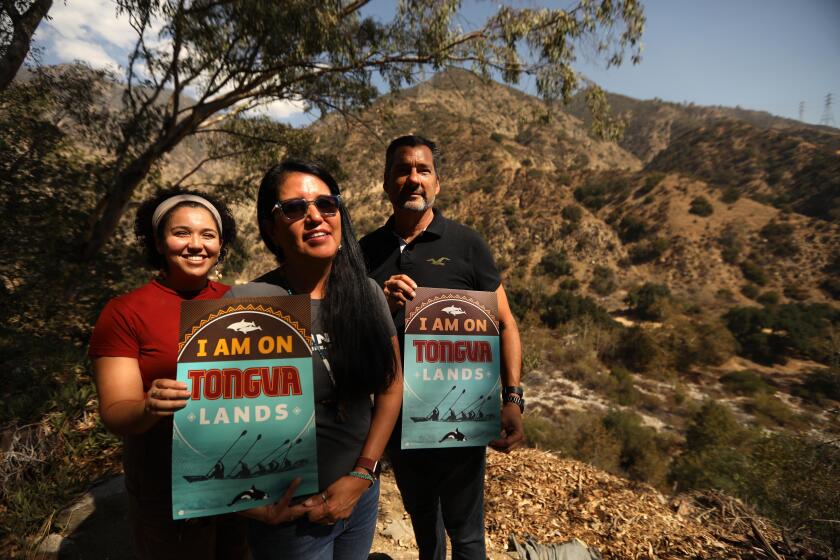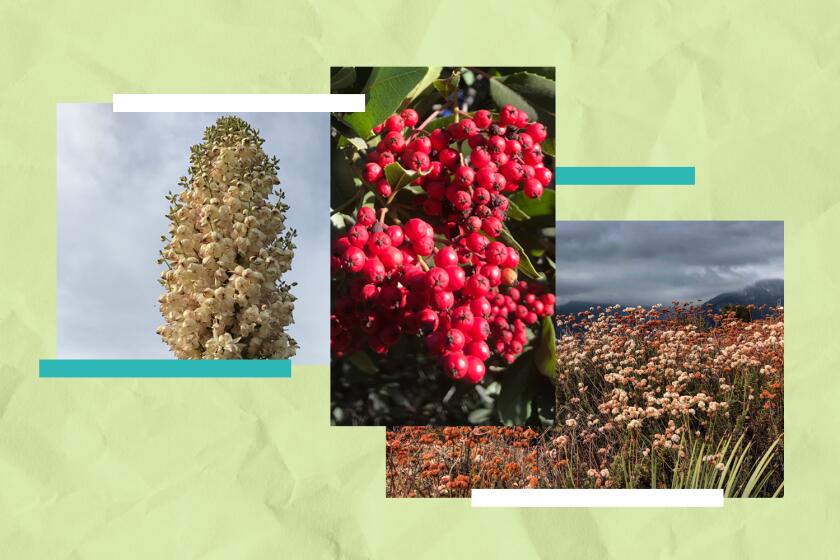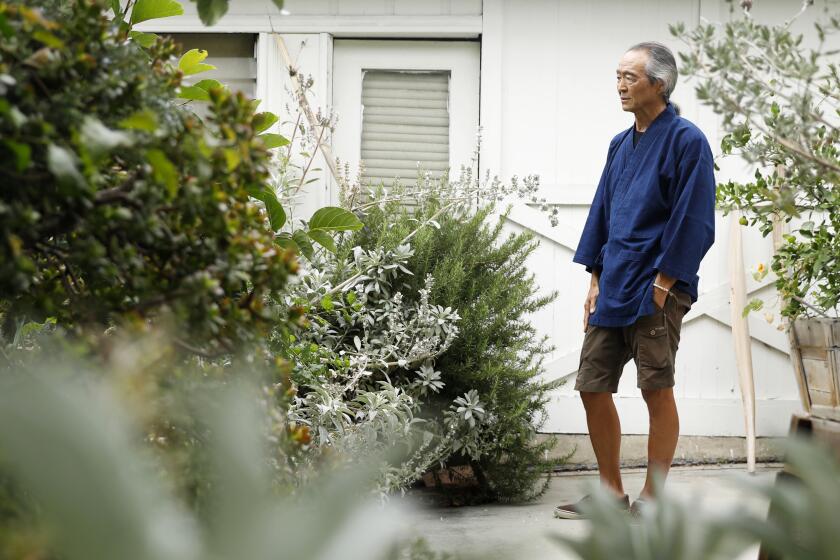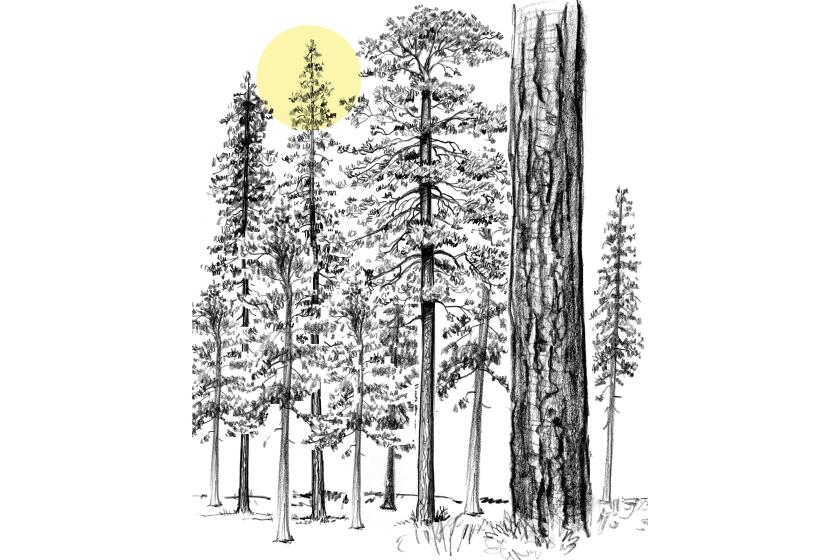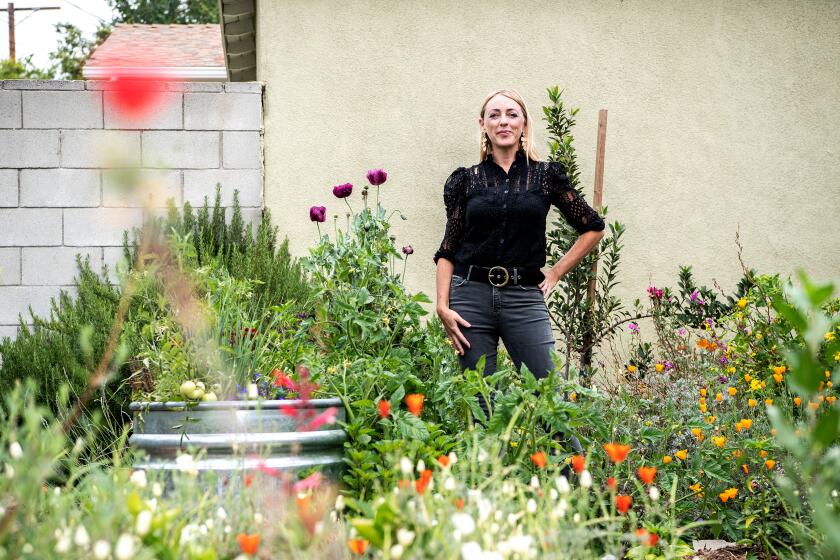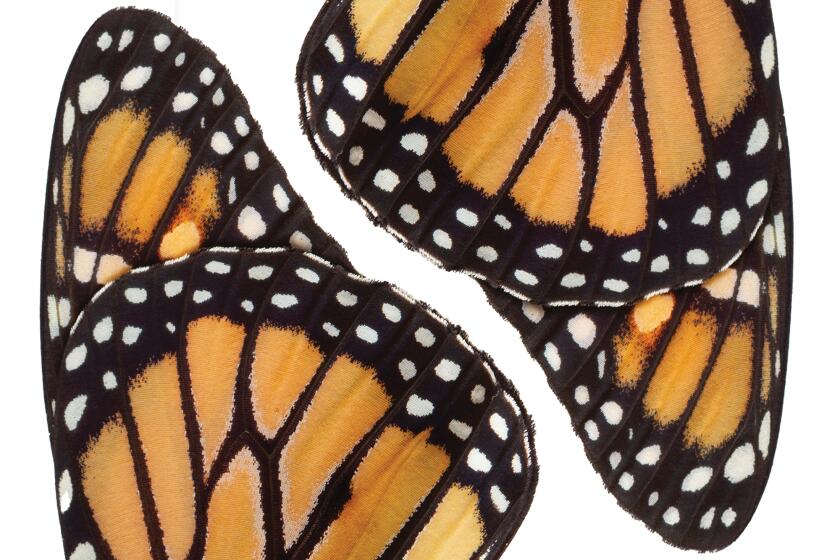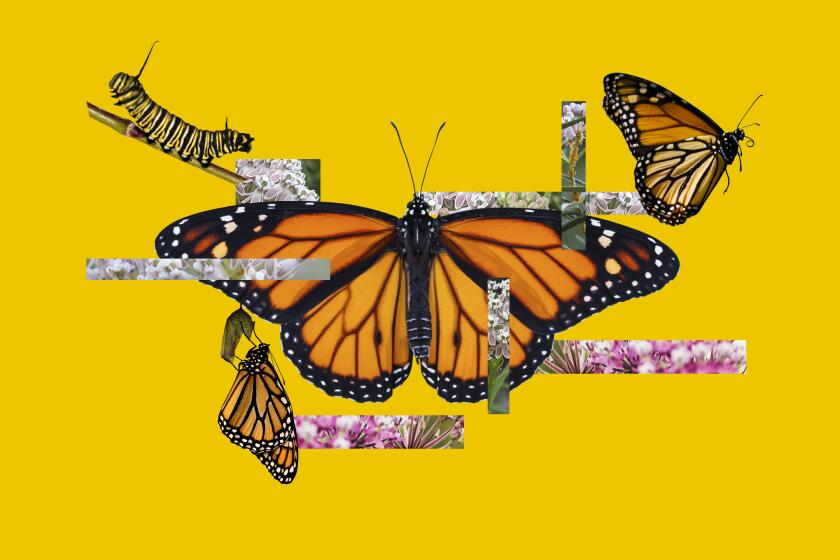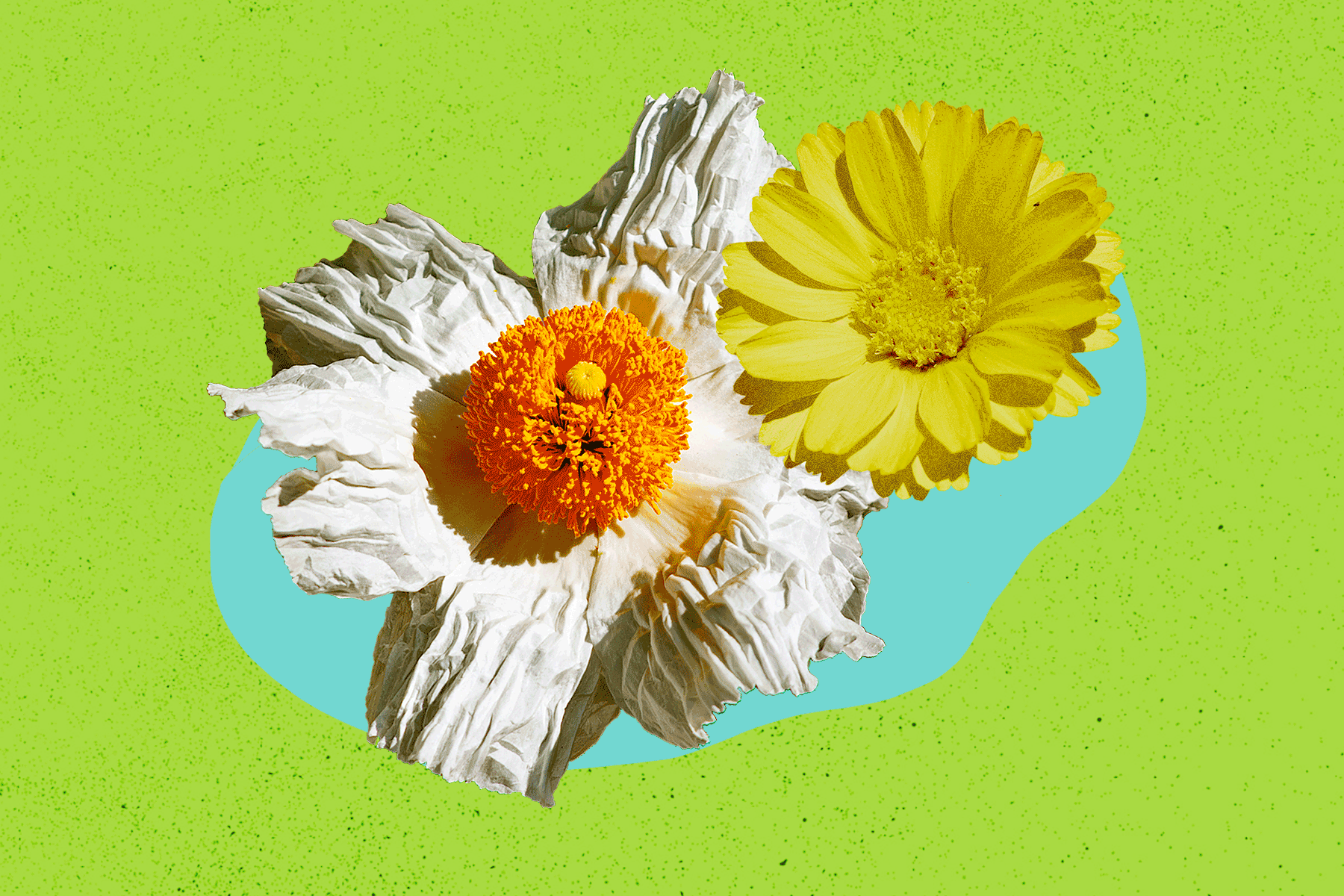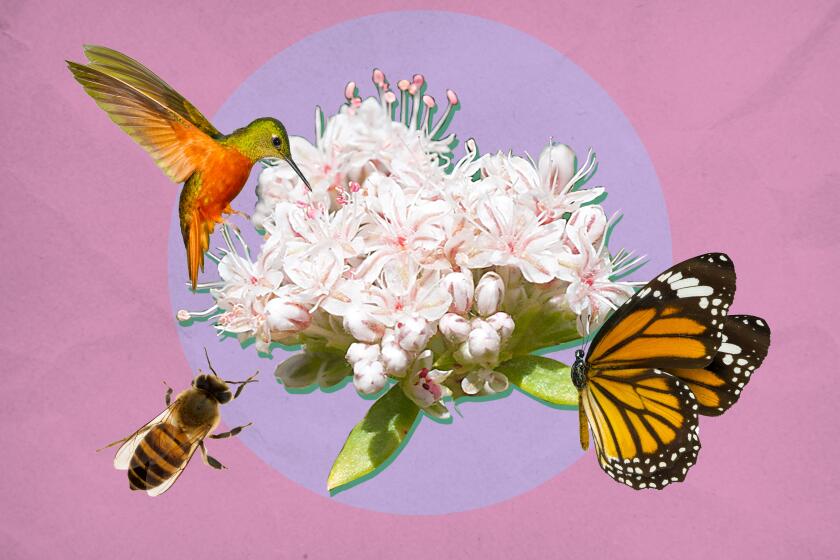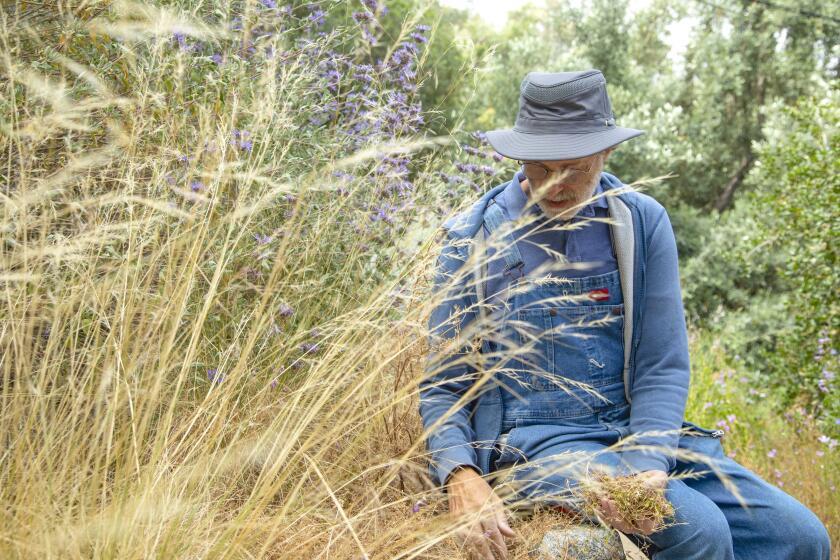Native voices were finally heard at California’s biggest native plant conference

- Share via
Something’s happened in the four years since the California Native Plant Society — CNPS — had its last statewide conference. The state’s premier environmental group “dedicated to the preservation and celebration of California’s native flora” finally got the memo about diversity and inclusion.
In 2018, most of the 900 attendees were affluent white folks listening to presentations from mostly white members of the state’s environmental establishment — namely researchers and scientists from universities and government agencies. This year’s conference in San Jose sold out with 1,200 attendees, the largest gathering in the organization’s 57-year history, and at least a quarter of the attendees were students and/or people of color, beneficiaries of about $50,000 in funds donated to improve racial and age diversity at the conference, said Liv O’Keeffe, the organization’s director of public affairs.
This year’s conference radiated inclusivity, starting with the introduction of CNPS’ new executive director, ecologist and former U.S. diplomat Jun Bando, the first Asian American to hold that post. Pronoun preferences were prominently displayed on everyone’s name tags. When queer attendees discovered there wasn’t an official gathering for them, they quietly spread the word about an LGBTQ mixer, and 26 people attended. Community science was celebrated. Lay scientists were included as speakers.
A one-acre property tucked within a canopy of oak trees and shrubs in Altadena has been transferred to Los Angeles’ first people.
And, for the first time, Native people played a significant role, not just as attendees but as speakers and presenters at multiple sessions, as part of CNPS’ quest to include new perspectives, such as the traditions of many California Native people who call for respectful human stewardship of native plants.
“There’s a growing understanding that the 20th century conservation movement is the byproduct of colonialism — that idea that humans created the problems in nature so nature has to be protected from humans,” O’Keeffe said after the conference. “But that mental model is changing. There are people across the world giving voice to the intersection of humans and nature, how we have to think about protecting ourselves and nature together, because we are in this together.”
The changes at CNPS have been evolving for years, with the formation of committees to address issues like equity, justice and Indigenous engagement, said Cris Sarabia, conservation director of the Palos Verdes Peninsula Land Conservancy and CNPS president in 2020 and 2021.
“We still have a long ways to go — in general, the whole conservation movement has a long ways to go — but we are trying to build a path that others can follow,” Sarabia said.
Indigenous cultural and plant educator Nicholas Hummingbird is on a mission to spread his knowledge of native plants through the traditional and ongoing knowledge of Indigenous peoples.
The new priorities were on full display at the conference, starting with the opening ceremony on Oct. 20, when Alexii Sigona, a UC Berkeley graduate student and member of the Amah Mutsun Tribal Band near Santa Cruz, challenged attendees to rethink their relationship with nature and how land is managed.
Sigona is firmly planted in the practical (his doctorate work is in environmental science policy and management), but his dissertation on collaborative management and land access for Indigenous peoples contains an essential spiritual piece. “For us, a lot of natural resources are cultural resources as well, and we think of them as relatives,” he said. “Colonialism caused us to see our relatives as resources for exploitation.”
This struggle between Indigenous and European perspectives came up repeatedly during the conference, even during its $80-a-plate celebration dinner (also sold out) with a menu created by the Chia Café Collective, an Indigenous grassroots group that published a cookbook called “Cooking the Native Way: Chia Café Collective.”
One of the cookbook authors, Tongva cultural educator and artist Craig Torres of Los Angeles, said he was taught to see plants and animals as “natural relatives, not natural resources. ... We learned that stones were the first people to emerge on the Earth, then the plant people and the animal people, and who was last? The humans, and we were given the major role to take care of everything that came before us.”
Georg Kochi moved to his family home and tore out the lawn. As he learned about native plants, he fell in love with drought-tolerant landscaping.
It’s hard to imagine those views getting much traction at previous conferences, but “the whole conservation community is going through a sea change,” Bando said after the conference, “from a place that really emphasized certain types of formally acquired expertise [to] the recognition that we need to broaden the types of expertise that inform our work.” One example: increasing research that supports some Native traditions, such as the value of controlled burns in cleaning out wildfire fuel.
Meanwhile, Sigona focused on the value of using land trusts to help tribes without federal recognition reclaim access to some of their ancestral lands. The Amah Mutsun people were splintered years ago by colonists and missionaries, he said, but creating the Amah Mutsun Land Trust on about 50 acres of their ancestral lands has allowed alienated tribal members to rediscover their “dormant” traditions such as gathering plants for medicine and basket making, performing traditional ceremonies and stewarding the land by removing invasive trees.
The process is healing, he said, especially to members fighting addiction, because it gives them purpose and direction. But it’s also challenging. Small tribes such as his will need partners and/or funding, he said, because they lack the numbers to manage large tracts of land.
“So far, [non-Indigenous] locals are skeptical about what we will do, and there are also stereotypes about Indians building casinos that come into play,” Sigona said. “The driving question is: What changes are needed to support Indigenous access to their ancestral lands?”
As California struggles with an increase in extreme wildfires, researchers are studying exactly what a healthy or fire-resistant forest looks like.
Here are eight other top takeaways from the three-day conference.
For the record:
2:52 p.m. Nov. 1, 2022Jennifer Norris’ position as deputy secretary of biodiversity and habitat for the California Natural Resources Agency was created in June 2020, not June of this year.
1. 30x30 funds are coming to the rescue
Ecologist Jennifer Norris, the new deputy secretary of biodiversity and habitat for the California Natural Resources Agency, offered some hope for funding and resources. Norris’ position was created in June 2020 to help shepherd funds and programs to satisfy the state’s 30x30 pledge to ensure that 30% of the land and coastal waters in California are set aside for conservation — i.e., “durably protected” by government ownership, land trusts or some other conservation means — by the year 2030, as part of the global 30x30 initiative.
The state Assembly has set aside $1.1 billion to $2 billion to help with land acquisition divided among various agencies, she said; that money could, for instance, help small tribal bands create land trusts to manage and freely access some of their ancestral lands. The rules for applying for those funds are still being written, but Norris said she expects them to be finalized by the end of the year. Find out more at californianature.ca.gov.
2. Community science now has cred
It used to be known as “citizen science,” a pat-on-the-head reference to people who did research without scientific degrees. Their work was often ignored or discounted by scientists, but thanks to new apps such as iNaturalist that allow users to pinpoint the dates and locations of their photos in the wild (or even their neighborhoods), and the sheer volume of data that’s required for land and plant studies, several presenters said lay scientists have become a crucial part of today’s environmental research. One of the most popular speakers at the conference was L.A. artist, photographer and self-described community scientist Krystle Hickman (@beesip), whose stunning photos of live native bees in the wild have both laypeople and scientists abuzz.
Los Angeles County residents have been removing their lawns to save money and water during the megadrought.
3. There’s now training to ‘decolonize in 12 not-so-easy steps’
Colonization was devastating to the Indigenous people of North America, pitting European standards of land ownership and exploitation head to head against a Native perspective of stewardship and open access. Those colonial values continue to color interactions and perspectives today, said Brenda Kyle, a California certified naturalist and interpretive guide and community engagement manager at the Theodore Payne Foundation in Sun Valley. Kyle said she’s gotten so many requests from people who want to “decolonize” their thinking that she’s created a short presentation based on th Alcoholics Anonymous’ 12-step program, starting with “Step No. 1: Admit there is a problem. If you cannot see the lasting effects of colonialism as a problem, you are not ready to decolonize.” She’s happy to share the presentation for a fee. Contact her on Instagram @chaparralchick.
4. A pre-fire cleanup saved the country’s largest oak tree
A hot-shot fire crew of 30 inmates from Vallecito Conservation Camp saved what’s believed to be the biggest oak tree in North America, a canyon live oak known as the Champion Oak, standing 97 feet tall, with a canopy nearly 100 feet wide, about 3,000 steep feet above Oak Glen in the San Bernardino National Forest.
The area hadn’t seen wildfires for 150 years, said Tim Krantz, conservation director of the Wildlands Conservancy in Oak Glen and retired University of Redlands environmental sciences professor, but in the summer of 2020 it was threatened by two back-to-back blazes. The first, known as the Apple fire, shifted away from the tree, allowing the crew to climb the steep slope carrying chainsaws and other heavy equipment in “blazing-hot temperatures.” They spent the day “raking up the duff” under the tree like fallen leaves, removing nearby brush and trimming the oak’s lower limbs. The Apple fire never touched that canyon, but their Herculean efforts paid off a month later, when the El Dorado fire roared through. Researchers had to wait 10 days before they could enter the area, where most of the trees and shrubs were burned to smoky stumps. But the Champion Oak was unscathed, Krantz said, except for a few singed leaves.
We spent the day with L.A. County’s top monarch butterfly counter, and ask: Can this endangered species survive?
5. You need to knock down invasive grasses before they smother native plants
At least three presenters suggested using cattle or even wild horses to reduce stands of invasive grasses, which typically grow faster and denser than native plants, especially after wildfires, denying native plants space and sunlight as they try to emerge. For instance, Stuart B. Weiss, chief scientist at the Creekside Center for Earth Observation in Los Gatos, said most people don’t realize that the atmospheric nitrogen from vehicle exhaust, smog and other emissions acts like fertilizer on invasive grasses, significantly goosing their growth to the detriment of native plants. Cattle grazing, he said, cuts down the invasives, giving native plants a fighting chance.
6. There’s a new resource for butterfly (and moth) gardens
Butterflies get all the attention because of their beauty, but moths actually do 95% of the pollinating among Lepidoptera, and they are as important to agriculture as they are to pollinating native plants, said UC Riverside ecology grad student Christopher Cosma, who is studying how climate change is affecting moths and their plant interactions. These fragile pollinators are threatened by “death from a thousand cuts,” he said, including habitat destruction, herbicides and pesticides, and when we lose butterflies and moths, it’s not just pollination at stake. We also lose the primary food source — caterpillars — for many of our songbirds.
So in the interest of helping everyone survive, Cosma has created a website to help people choose the best native plants for the Lepidoptera that live in their ZIP Codes. Just enter your street address at ctcosma.shinyapps.io/the_butterfly_net to get a list of at least 10 native plants that best support the butterflies and moths in your area.
Monarch butterfly populations are endangered, to the point that the 1.2 million Western monarchs counted in 1997 plummeted to fewer than 2,000 by 2020. Here are ways we can help them survive.
7. There’s a new L.A.-based BIPOC group devoted to native plants
The native plant world hasn’t always felt welcoming to people of color, said Sarabia, so he and Blanca Diaz, manager of the native plant nursery and maintenance at Willow Springs Park in Long Beach, started a group in February 2021 to help members of the BIPOC community interested in native plants find a safe and encouraging place to learn more. Membership is free, but you have to sign up on Instagram (@BIPOC.ifornia) and identify yourself as BIPOC to join events, which this year included hikes, field trips, presentations and making origami artwork that resembles native plants.
8. Demand for native plants is strong
CNPS launched its Bloom California campaign in the fall of 2021 to help lawn removers relandscape with native plants. More than 100 nurseries in California joined the online campaign, agreeing to display the Bloom California logo and sell the native plants featured on the website. The marketing paid off in a big way, especially in Southern California. Participating nurseries reported a 67% increase in native plant sales compared to two years earlier. The website offers design tips and specific plant suggestions for a variety of native gardens, from privacy hedgerows and pots on a balcony to a shady retreat or a sunny pollinator paradise.
Even California native plants can dry out in the summer. But these varieties will still look good in Los Angeles yards and gardens during the hottest months.
Late fall is a great time to shop for California native plants and get them in the ground, to establish themselves during the cooler and (we hope) wetter months of the year. The following calendar lists several native plant sales around Southern California in November, along with other plant-related events and activities. Email events to [email protected] at least three weeks before they happen, and we might include them in the calendar.
Nov. 4-5
San Gabriel Valley Chrysanthemum Society 90th Chrysanthemum Show and Sale at the Pasadena City Church, 2594 E. Colorado Blvd., in Pasadena, from 1 to 4 p.m. on Nov. 4 and 9 a.m. to 4 p.m. on Nov. 5. Admission is free. 72note.com
Nov. 5
Converting Your Lawn workshop with Urban Farms LA, 11 a.m. to noon at Fig Earth Supply, 3577 N. Figueroa St. in Mount Washington, includes the basics on lawn removal, mulching, considerations when adding native plants, what kind of irrigation is necessary and an explanation of “water retention features” required in turf removal rebate programs. Register online, $20. figearthsupply.com
Monarch Nature Trail Volunteer Day, 9 to 11 a.m. at 5302 Rancho Road in Huntington Beach. The UC Cooperative Extension Master Gardeners of Orange County is sponsoring the event, promising volunteer tasks for all ages, including watering, seed collection, mulching and weeding. Participants should wear tennis shoes, hats and sunscreen and bring drinking water. There are no restrooms available at the site. Admission is free and no registration is required. mgorange.ucanr.edu
10th Ventura County Farm Day is a free event sponsored by SEEAG, a nonprofit that educates students and the community about farming. Visitors can take self-guided tours of 15 farms, ranches and agricultural operations in Ventura County between 10 a.m. to 3 p.m. Tour times vary per location, so check out the trail map online. venturacountyfarmday.com
UC Master Gardener Program of Ventura County presents Farm Day 2022, 10 a.m. to 3 p.m. at the Hansen Agricultural Research and Education Center, 287 S. Briggs Road in Santa Paula. The event includes a $20 class in making succulent pumpkin centerpieces from 10:30 to noon (all materials included, advance registration required) as well as self-guided walking tours of the farm; a U-pick vegetable garden for children 12 and under; Master Gardener presentations about composting, tree care and irrigation; and activities for children led by Ventura County 4-H Clubs. Admission and parking are free but registration is required. harec.ucanr.edu
Nov. 8-12, 15-19
Theodore Payne Foundation Fall Native Plant Sale, a 10-day event that includes the native plant nursery’s biggest selection of the year, with plants, seeds and bulbs at a 10% discount (15% discount for members), from 8:30 a.m. to 4 p.m. at 10459 Tuxford St. in Sun Valley. The inventory will be restocked at the end of the second week. Admission is free but shoppers are asked to reserve a space for their cars, since parking spaces are limited. theodorepayne.org
Nov. 9
Ventura Land Trust’s Community Meeting on plans for sustainable trails and recreation on the newly acquired Mariano Rancho Preserve in the hills above Ventura, 6:30 p.m. at De Anza Middle School, 2060 Cameron St., in Ventura. The event is free, but attendees are asked to RSVP online, where people can also submit comments and questions. venturalandtrust.org
Free screening of the “Saging the World” documentary at 7:30 p.m. at the Norman P. Murray Community Center, 24932 Veterans Way in Mission Viejo, sponsored by the Orange County chapter of the California Native Plant Society. The organization is also passing out free 4-inch pots to the first 96 people who attend the screening, as part of its Sage in Every Garden campaign. califorianativeplants.com
Nov. 11
“Garden for Life,” a talk by Toni Gattone at the Sherman Library & Gardens “Lunch & Lecture” series, 11:30 a.m. to 1 p.m. at 2647 East Coast Hwy. in Corona del Mar. Gattone, author of “The Lifelong Gardener: Garden with Ease & Joy at Any Age” will discuss ways to adjust your garden’s size and accessibility with ergonomic tools, raised beds, vertical gardening and other techniques. Lunch is at 11:30 a.m., the talk begins at noon. Tickets are $50 ($40 for members) or $5 for the lecture only (free to members). Register online. thesherman.org
The new wave in landscaping is building habitat by growing native plants, but you don’t need a yard to promote biodiversity. Hummingbirds, butterflies, bees and other pollinators are happy to dine on native plants growing on balconies or patios.
Nov. 12
Tree of Life Nursery Sage Festival, co-sponsored by the Orange County Chapter of the California Native Plant Society, 9 a.m. to 3:30 p.m. at the nursery, 33201 Ortega Hwy. , in San Juan Capistrano. The event focuses on all the different varieties of native sage plants, with a variety of speakers discussing horticultural uses of sage, the varieties of sage found in Southern California, and plants and pollinators that interact best with sage plants. Rose Ramirez and Deborah Small, producers of the “Saging the World” documentary, will also discuss their film, which will be screened for free Nov. 9 (see above). The event will also include vendors selling food and other items, and the Orange County Chapter of CNPS will be giving away 4-inch white sage plants, one per household, as part of its Sage in Every Garden campaign to distribute 2,000 white sage plants to Orange County households. Admission is free. californianativeplants.com
San Gabriel Mountains chapter of the California Native Plant Society Fall Plant Sale, 9 a.m. to 2 p.m. at the Monrovia Historical Museum, 742 E. Lemon Ave. in Monrovia, features native plants as well as T-shirts, books and art work by local artists and other vendors. Admission is free. cnps-sgm.org
Growing Works native plant nursery retail sale, 10 a.m. to 2 p.m. at 1736 S. Lewis Road in Camarillo. The wholesale nursery is a project of the Turning Point Foundation to provide housing, treatment and jobs for adults with mental illness and is now open once a month o the public. A list of their available plants is online. turningpointfoundation.org
Fig Earth Supply’s Indoor Plant Class, 11 a.m. to noon at 3577 N. Figueroa St. in Mount Washington. Learn the basics about houseplant care. Register online, admission is $5. figearthsupply.com
Nov. 13
California Botanic Garden’s Waterwise Community Festival is a free event featuring f water conservation and lawn removal workshops, crafts, storytelling and other activities for children, live music, food trucks and a chance to purchase native plants at the garden’s Grow Native Nursery, 10 a.m. to 3 p.m. at 1500 North College Ave. in Claremont. Visitors can also tour the garden’s 88 acres of California native plants for free. calbg.org
South Coast Cactus & Succulent Society‘s November meeting features Kelly Griffin, succulent plant development manager for Altman’s Plants in Vista, and a succulent hybridizer, propagator and plant explorer talking about what he saw on two trips to Socotra, a Yemeni island in the northwest Indian Ocean near the Gulf of Aden. The meeting is at 1 p.m. at the South Coast Botanic Garden, 26300 Crenshaw Blvd., in Rolling Hills Estates. Griffin will be bringing some of his hybrids and seed-grown plants to the meeting for purchase. southcoastcss.org
Native plant gardens can look dead over the summer, but there are things you can do to tend to the dried-out vegetation.
Fig Earth Supply’s Learn to Grow: Ranunculus, taught by Joan Stevens of Mamabotanica Blooms, 11 a.m. to noon at 3577 N. Figueroa St. in Mount Washington. Learn the basics of growing these beautiful but tricky flowers. Tickets are $10 and include five ranunculus corms to help you get started. (More corms and varieties available for sale.)
Register online, figearthsupply.com
Nov. 19
Greywater Corps’ laundry to landscape (L2L) workshop is a hands-on, day-long opportunity to learn about building a gray-water irrigation system at a private residence in Highland Park from 9 a.m. to 4 p.m. These systems do not require permits and allow users to irrigate their yard with used water from their washing machines, according to the organizers. “Almost anyone with a washer and a yard to irrigate can build one themselves,” according to press release from Greywater Corps, which has been installing residential gray water and rainwater systems in L.A. County since 2009. Tickets to the workshop are $150. This is their final hands-on workshop for 2022. greywatercorps.com
Nov. 21-23
Autumn Nature Camp at the Los Angeles County Arboretum & Botanic Garden, offers autumn-themed plant and garden activities from 9 a.m. to 5 p.m. during the first three days of Thanksgiving week for children ages 5 to 10 at 301 N. Baldwin Ave. in Arcadia. Register online, $275 ($265 for members). arboretum.org
More to Read
Sign up for The Wild
We’ll help you find the best places to hike, bike and run, as well as the perfect silent spots for meditation and yoga.
You may occasionally receive promotional content from the Los Angeles Times.
